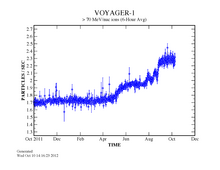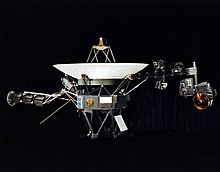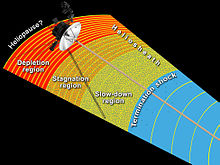Cosmic Ray Subsystem: Difference between revisions
MOS:DASH, link maintenance, refine ref details |
|||
| Line 1: | Line 1: | ||
[[File:Cosmic Rays at Voyager 1.png|thumb|This shows cosmic ray hits as recorded by ''Voyager 1'' from |
[[File:Cosmic Rays at Voyager 1.png|thumb|This shows cosmic ray hits as recorded by ''Voyager 1'' from 2011–2012, a time when it is thought to have finally exited the Heliosphere]] |
||
[[File:VoyagerCRSinred.jpg|thumb|CRS highlighted in red]] |
[[File:VoyagerCRSinred.jpg|thumb|CRS highlighted in red]] |
||
[[File:Voyager.jpg|thumb|A voyager spacecraft. CRS is on the boom on the right, but to the left of the cameras]] |
[[File:Voyager.jpg|thumb|A voyager spacecraft. CRS is on the boom on the right, but to the left of the cameras]] |
||
[[File:HD.6B.155 (10727124456).jpg|thumb|The CRS is detecting extremely small particles as might be detected in a [[bubble chamber]] or [[cloud chamber]], which can show the tracks certain particles make as they travel]] |
[[File:HD.6B.155 (10727124456).jpg|thumb|The CRS is detecting extremely small particles as might be detected in a [[bubble chamber]] or [[cloud chamber]], which can show the tracks certain particles make as they travel]] |
||
[[File:Transitional regions.jpg|thumb|A view of the outer solar system as discovered by Voyager as of June 2013]] |
[[File:Transitional regions.jpg|thumb|A view of the outer solar system as discovered by Voyager as of June 2013]] |
||
'''Cosmic Ray Subsystem''' ('''CRS''', or '''Cosmic Ray System''')<ref name="Team">{{Cite web|url=http://voyager.gsfc.nasa.gov/objectives.html|title=OBJECTIVES|last=Team|first=Voyager Cosmic Ray Subsystem|website=voyager.gsfc.nasa.gov|access-date=2017-01-13}}</ref> is an instrument aboard the ''[[Voyager 1]]'' and ''[[Voyager 2]]'' spacecraft of the NASA [[Voyager program]], and it is an experiment to detect [[cosmic rays]].<ref>{{Cite web|url=http://nssdc.gsfc.nasa.gov/nmc/experimentDisplay.do?id=1977-076A-08|title=NASA - NSSDCA - Experiment - Details for Voyager 2|website=nssdc.gsfc.nasa.gov|access-date=2017-01-13}}</ref><ref>{{Cite web|url=http://nssdc.gsfc.nasa.gov/nmc/experimentDisplay.do?id=1977-084A-08|title=NASA - NSSDCA - Experiment - Details for Voyager 1|website=nssdc.gsfc.nasa.gov|access-date=2017-01-13}}</ref> The CRS includes a High-Energy Telescope System (HETS), Low-Energy Telescope System (LETS), and The Electron Telescope (TET).<ref name="voyagercss"/> It is designed to detect energetic particles and some the requirements were for the instrument to be reliable and to have enough charge resolution.<ref>{{cite journal|title=1977SSRv...21..355S Page 355|journal = Space Science Reviews|volume = 21|issue = 3|pages = 355|bibcode = 1977SSRv...21..355S|last1 = Stone|first1 = E. C.|last2 = Vogt|first2 = R. E.|last3 = McDonald|first3 = F. B.|last4 = Teegarden|first4 = B. J.|last5 = Trainor|first5 = J. H.|last6 = Jokipii|first6 = J. R.|last7 = Webber|first7 = W. R.|year = 1977|doi = 10.1007/BF00211546}}</ref> It can also detect the energetic particles like protons from the [[Galaxy]] or Earth's [[Sun]].<ref name="Team"/> As of 2017, CRS is one of the active remaining instruments on both Voyager spacecraft, and it is described by as being able to detect electrons from |
'''Cosmic Ray Subsystem''' ('''CRS''', or '''Cosmic Ray System''')<ref name="Team">{{Cite web|url=http://voyager.gsfc.nasa.gov/objectives.html|title=OBJECTIVES|last=Team|first=Voyager Cosmic Ray Subsystem|website=voyager.gsfc.nasa.gov|access-date=2017-01-13}}</ref> is an instrument aboard the ''[[Voyager 1]]'' and ''[[Voyager 2]]'' spacecraft of the NASA [[Voyager program]], and it is an experiment to detect [[cosmic rays]].<ref>{{Cite web|url=http://nssdc.gsfc.nasa.gov/nmc/experimentDisplay.do?id=1977-076A-08|title=NASA - NSSDCA - Experiment - Details for Voyager 2|website=nssdc.gsfc.nasa.gov|access-date=2017-01-13}}</ref><ref>{{Cite web|url=http://nssdc.gsfc.nasa.gov/nmc/experimentDisplay.do?id=1977-084A-08|title=NASA - NSSDCA - Experiment - Details for Voyager 1|website=nssdc.gsfc.nasa.gov|access-date=2017-01-13}}</ref> The CRS includes a High-Energy Telescope System (HETS), Low-Energy Telescope System (LETS), and The Electron Telescope (TET).<ref name="voyagercss"/> It is designed to detect energetic particles and some the requirements were for the instrument to be reliable and to have enough charge resolution.<ref>{{cite journal|title=1977SSRv...21..355S Page 355|journal = Space Science Reviews|volume = 21|issue = 3|pages = 355|bibcode = 1977SSRv...21..355S|last1 = Stone|first1 = E. C.|last2 = Vogt|first2 = R. E.|last3 = McDonald|first3 = F. B.|last4 = Teegarden|first4 = B. J.|last5 = Trainor|first5 = J. H.|last6 = Jokipii|first6 = J. R.|last7 = Webber|first7 = W. R.|year = 1977|doi = 10.1007/BF00211546}}</ref> It can also detect the energetic particles like protons from the [[Galaxy]] or Earth's [[Sun]].<ref name="Team"/> As of 2017, CRS is one of the active remaining instruments on both Voyager spacecraft, and it is described by as being able to detect electrons from 3–110 MeV and cosmic ray nuclei 1–500 MeV/n.<ref>{{Cite web|url=http://voyager.jpl.nasa.gov/spacecraft/index.html|title=Voyager - The Interstellar Mission|last=JPL.NASA.GOV|website=voyager.jpl.nasa.gov|access-date=2017-01-13}}</ref> All three systems used [[Solid-state electronics|solid-state]] detectors.<ref name="voyager.gsfc.nasa.gov">{{Cite web|url=http://voyager.gsfc.nasa.gov/instruments.html#LET|title=INSTRUMENTS|last=Team|first=Voyager Cosmic Ray Subsystem|website=voyager.gsfc.nasa.gov|language=en|access-date=2017-02-02}}</ref> CRS is one of the five fields and particle experiments on each spacecraft, and one of the goals is to gain a deeper understanding of the [[solar wind]].<ref>{{Cite book|url=https://books.google.com/books?id=MW4zvCyjHtQC&pg=PA283|title=NASA's Voyager Missions: Exploring the Outer Solar System and Beyond|last=Evans|first=Ben|last2=Harland|first2=David M.|date=2008|publisher=Springer Science & Business Media|isbn=978-1-85233-745-2|page=67}}</ref> Other objects of study including [[Electron|electrons]] and [[Atomic nucleus|nuclei]] from planetary [[magnetosphere]]s and from outside the solar system.<ref>{{Cite book|url=https://books.google.com/books?id=Gp-2B7AUPVUC&pg=PA218|title=Deep Space Craft: An Overview of Interplanetary Flight|last=Doody|first=Dave|date=2010|publisher=Springer Science & Business Media|isbn=978-3-540-89510-7|page=218}}</ref> |
||
==Overview== |
==Overview== |
||
| Line 25: | Line 25: | ||
*The TET measures the energy spectrum of electrons from 3 to 110 MeV.<ref name=voyagercss/> |
*The TET measures the energy spectrum of electrons from 3 to 110 MeV.<ref name=voyagercss/> |
||
The TET consists of eight solid state detectors with different thicknesses of [[tungsten]] between each detector.<ref>{{Cite web|url=http://voyager.gsfc.nasa.gov/instruments.html#HET|title=INSTRUMENTS|last=Team|first=Voyager Cosmic Ray Subsystem|website=voyager.gsfc.nasa.gov|language=en|access-date=2017-02-02}}</ref> The detectors and tungsten layers are stacked one on top of each other.<ref name="ReferenceA"/> The tungsten layers range from 0.56 mm to 2.34 mm thick and function as absorbers. Each TET solid state detector has an area of 4.5 |
The TET consists of eight solid state detectors with different thicknesses of [[tungsten]] between each detector.<ref>{{Cite web|url=http://voyager.gsfc.nasa.gov/instruments.html#HET|title=INSTRUMENTS|last=Team|first=Voyager Cosmic Ray Subsystem|website=voyager.gsfc.nasa.gov|language=en|access-date=2017-02-02}}</ref> The detectors and tungsten layers are stacked one on top of each other.<ref name="ReferenceA"/> The tungsten layers range from 0.56 mm to 2.34 mm thick and function as absorbers. Each TET solid state detector has an area of 4.5 cm<sup>2</sup> and is 3 mm thick.<ref name="ReferenceA">{{Cite web|url=http://voyager.gsfc.nasa.gov/heliopause/vim/electrons/voyager2/index.html|title=Voyager Cosmic Ray Subsystem|last=Team|first=Voyager Cosmic Ray Subsystem|website=voyager.gsfc.nasa.gov|language=en|access-date=2017-02-11}}</ref> |
||
The P.I. is Prof. [[Edward C. Stone]], Jr.<ref>{{Cite web|url=http://nssdc.gsfc.nasa.gov/nmc/experimentDisplay.do?id=1977-084A-08|title=NASA - NSSDCA - Experiment - Details|website=nssdc.gsfc.nasa.gov|access-date=2017-02-02}}</ref> |
The P.I. is Prof. [[Edward C. Stone]], Jr.<ref>{{Cite web|url=http://nssdc.gsfc.nasa.gov/nmc/experimentDisplay.do?id=1977-084A-08|title=NASA - NSSDCA - Experiment - Details|website=nssdc.gsfc.nasa.gov|access-date=2017-02-02}}</ref> |
||
| Line 32: | Line 32: | ||
In 1977 the spectra of Helium (He), Carbon, Nitrogen, Oxygen, and Neon during the [[solar minimum]] was measured using the CRS instrument on the Voyagers that year.<ref name="auto">{{cite journal|url=http://authors.library.caltech.edu/44774/|title=Evidence that the anomalous cosmic-ray component is singly ionized|pages=L99–L103|first1=Cummings, A.|last1=C.|first2=Stone, E.|last2=C.|first3=Webber, W.|last3=R.|date=15 December 1984|journal=Astrophysical Journal Letters|volume=287|bibcode=1984ApJ...287L..99C|doi=10.1086/184407}}</ref> The solar minimum of 1977 occurred towards the end of year, and it was possible to observe both interplanetary, galactic, and anomalous energy spectras.<ref name="auto"/> |
In 1977 the spectra of Helium (He), Carbon, Nitrogen, Oxygen, and Neon during the [[solar minimum]] was measured using the CRS instrument on the Voyagers that year.<ref name="auto">{{cite journal|url=http://authors.library.caltech.edu/44774/|title=Evidence that the anomalous cosmic-ray component is singly ionized|pages=L99–L103|first1=Cummings, A.|last1=C.|first2=Stone, E.|last2=C.|first3=Webber, W.|last3=R.|date=15 December 1984|journal=Astrophysical Journal Letters|volume=287|bibcode=1984ApJ...287L..99C|doi=10.1086/184407}}</ref> The solar minimum of 1977 occurred towards the end of year, and it was possible to observe both interplanetary, galactic, and anomalous energy spectras.<ref name="auto"/> |
||
In the early 1980s, the CRS detected charged particles around [[Saturn]].<ref name="auto1">{{Cite book|url=https://books.google.com/?id=tJnsCAAAQBAJ&pg=PA343 |
In the early 1980s, the CRS detected charged particles around [[Saturn]].<ref name="auto1">{{Cite book|url=https://books.google.com/books?id=tJnsCAAAQBAJ&pg=PA343|title=Astronomy and Astrophysics Abstracts: Literature 1982|last=Böhme|first=S.|last2=Fricke|first2=W.|last3=Hefele|first3=H.|last4=Heinrich|first4=I.|last5=Hofmann|first5=W.|last6=Krahn|first6=D.|last7=Matas|first7=V. R.|last8=Schmadel|first8=L. D.|last9=Zech|first9=G.|date=2013|publisher=Springer Science & Business Media|isbn=978-3-662-12334-8|page=343}}</ref> It detected a 0.43 million volt flux of protons as it reach Saturn's [[magnetosphere]].<ref name="auto1"/> In the 1980s the CRS data from both Voyagers was used to determine the abundances of energetic particles from the Sun and additional information.<ref>{{Cite book|url=https://books.google.com/books?id=I0b1CAAAQBAJ&pg=PA380|title=Literature 1985|last=Böhme|first=S.|last2=Esser|first2=U.|last3=Fricke|first3=W.|last4=Hefele|first4=H.|last5=Heinrich|first5=I.|last6=Hofmann|first6=W.|last7=Krahn|first7=D.|last8=Matas|first8=V. R.|last9=Schmadel|first9=L. D.|date=2013|publisher=Springer Science & Business Media|isbn=978-3-662-11178-9|page=380}}</ref> Another area studied in the 1980s using CRS data was variation in [[Galactic cosmic rays]] in the outer Heliosphere<ref>{{cite journal|title=Variations of Galactic Cosmic Rays with Heliolatitude in the Outer Heliosphere|journal = International Cosmic Ray Conference|volume = 3|pages = 393|bibcode = 1987ICRC....3..393M|last1 = McDonald|first1 = F. B.|last2 = Lal|first2 = N.|year = 1987}}</ref> |
||
CRS helped predict that ''Voyager 1'' and ''2'' would cross the Solar system's termination shock in 2003.<ref>{{Cite journal|title=Cosmic-ray subsystem - Oxford Reference|url=http://www.oxfordreference.com/view/10.1093/oi/authority.20110803095641369}}</ref> This helped support the later conclusion that ''Voyager 1'' crossed the termination shock in December 2004 and that ''Voyager 2'' crossed it in August 2007.<ref name="nature.com">{{cite journal|url=http://www.nature.com/news/voyager-s-long-goodbye-1.11348|title=Voyager's long goodbye|first=Ron|last=Cowen|date=5 September 2012|journal=Nature|volume=489|issue=7414|pages=20–21|doi=10.1038/489020a|bibcode=2012Natur.489...20C}}</ref> |
CRS helped predict that ''Voyager 1'' and ''2'' would cross the Solar system's termination shock in 2003.<ref>{{Cite journal|title=Cosmic-ray subsystem - Oxford Reference|url=http://www.oxfordreference.com/view/10.1093/oi/authority.20110803095641369}}</ref> This helped support the later conclusion that ''Voyager 1'' crossed the termination shock in December 2004 and that ''Voyager 2'' crossed it in August 2007.<ref name="nature.com">{{cite journal|url=http://www.nature.com/news/voyager-s-long-goodbye-1.11348|title=Voyager's long goodbye|first=Ron|last=Cowen|date=5 September 2012|journal=Nature|volume=489|issue=7414|pages=20–21|doi=10.1038/489020a|bibcode=2012Natur.489...20C}}</ref> |
||
| Line 53: | Line 53: | ||
==External links== |
==External links== |
||
*[http://adsabs.harvard.edu/full/1977SSRv...21..355S Cosmic ray investigation for the Voyager missions: Energetic particle studies in the outer heliosphere |
*[http://adsabs.harvard.edu/full/1977SSRv...21..355S Cosmic ray investigation for the Voyager missions: Energetic particle studies in the outer heliosphere – and beyond, Stone, et al] |
||
*[http://helios.gsfc.nasa.gov/cosmic.html NASA |
*[http://helios.gsfc.nasa.gov/cosmic.html NASA – Cosmic Rays] (general overview of CR) |
||
*[http://voyager.gsfc.nasa.gov/objectives.html Objective of CRS] |
*[http://voyager.gsfc.nasa.gov/objectives.html Objective of CRS] |
||
*[http://voyager.jpl.nasa.gov/science/bibliography_crs.html Papers by decade from CRS] |
*[http://voyager.jpl.nasa.gov/science/bibliography_crs.html Papers by decade from CRS] |
||
*[http://voyager.gsfc.nasa.gov/ CRS] |
*[http://voyager.gsfc.nasa.gov/ CRS] |
||
*[http://voyager.jpl.nasa.gov/spacecraft/instruments_crs.html Voyager Instruments |
*[http://voyager.jpl.nasa.gov/spacecraft/instruments_crs.html Voyager Instruments – Cosmic Ray Subsystem] |
||
*[http://voyager.gsfc.nasa.gov/heliopause/v2la1.html CRS |
*[http://voyager.gsfc.nasa.gov/heliopause/v2la1.html CRS – Graphs] |
||
*[http://voyager.gsfc.nasa.gov/heliopause/vim/electrons/voyager2/index.html TET info] |
*[http://voyager.gsfc.nasa.gov/heliopause/vim/electrons/voyager2/index.html TET info] |
||
Revision as of 06:52, 28 December 2018





Cosmic Ray Subsystem (CRS, or Cosmic Ray System)[1] is an instrument aboard the Voyager 1 and Voyager 2 spacecraft of the NASA Voyager program, and it is an experiment to detect cosmic rays.[2][3] The CRS includes a High-Energy Telescope System (HETS), Low-Energy Telescope System (LETS), and The Electron Telescope (TET).[4] It is designed to detect energetic particles and some the requirements were for the instrument to be reliable and to have enough charge resolution.[5] It can also detect the energetic particles like protons from the Galaxy or Earth's Sun.[1] As of 2017, CRS is one of the active remaining instruments on both Voyager spacecraft, and it is described by as being able to detect electrons from 3–110 MeV and cosmic ray nuclei 1–500 MeV/n.[6] All three systems used solid-state detectors.[7] CRS is one of the five fields and particle experiments on each spacecraft, and one of the goals is to gain a deeper understanding of the solar wind.[8] Other objects of study including electrons and nuclei from planetary magnetospheres and from outside the solar system.[9]
Overview
Areas of original study for this investigation:[10]
- origin and acceleration process, life history, and dynamic contribution of interstellar cosmic rays,
- nucleosynthesis of elements in cosmic-ray sources
- behavior of cosmic rays in the interplanetary medium
- trapped planetary energetic particle environment.
High-Energy Telescope System:[4]
- 6 and 500 MeV/nucleon for atomic numbers from 1 through 30
- Electrons from 3 and 100 MeV
Low-Energy Telescope System:[4]
- 0.15 and 30 MeV/nucleon for atomic numbers from 1 to 30.
- Measures anisotropies of electrons and nuclei.
Electron Telescope (TET):
- The TET measures the energy spectrum of electrons from 3 to 110 MeV.[4]
The TET consists of eight solid state detectors with different thicknesses of tungsten between each detector.[11] The detectors and tungsten layers are stacked one on top of each other.[12] The tungsten layers range from 0.56 mm to 2.34 mm thick and function as absorbers. Each TET solid state detector has an area of 4.5 cm2 and is 3 mm thick.[12]
The P.I. is Prof. Edward C. Stone, Jr.[13]
Results
In 1977 the spectra of Helium (He), Carbon, Nitrogen, Oxygen, and Neon during the solar minimum was measured using the CRS instrument on the Voyagers that year.[14] The solar minimum of 1977 occurred towards the end of year, and it was possible to observe both interplanetary, galactic, and anomalous energy spectras.[14]
In the early 1980s, the CRS detected charged particles around Saturn.[15] It detected a 0.43 million volt flux of protons as it reach Saturn's magnetosphere.[15] In the 1980s the CRS data from both Voyagers was used to determine the abundances of energetic particles from the Sun and additional information.[16] Another area studied in the 1980s using CRS data was variation in Galactic cosmic rays in the outer Heliosphere[17]
CRS helped predict that Voyager 1 and 2 would cross the Solar system's termination shock in 2003.[18] This helped support the later conclusion that Voyager 1 crossed the termination shock in December 2004 and that Voyager 2 crossed it in August 2007.[19]
In 2011, CRS data along with the Voyager Magnetometer discovered an area where the solar wind was not going in either direction.[20] The area was identified as a sort of charged particle doldrums, where the particles from the solar system are pushed back by cosmic forces.[20] At a distance of 17 light-hours Voyager 1 was commanded to rotate several times (in the other direction then its spinning), to make detection in other directions.[19]
It was determined that in 2012 Voyager 1 entered interstellar space, that is it entered the interstellar medium between the stars.[21] One of the reasons this was recognized was the increase in galactic cosmic rays.[22]
In 2013 CRS data lead some to propose that Voyager 1 had entered a "transition zone" as it leaves Heliosphere.[23] There was a big drop in the amount of cosmic rays being detected that triggered a lot of analysis.[24] The results from the magnetometer muddied the waters of interpretation.[25]
First I don't think any of us on the CRS [Cosmic Ray Subsystem, an instrument on Voyager] team will ever forget watching on the computer monitors, even on an hourly basis, in one case, as some particle intensities dropped precipitously, and others increased simultaneously on several occasions in July and August, 2012.
— [26]
Other scientists proposed that this indicated a departure from the solar system in the sense that it had left the Sun's heliosphere.[24] The issue was the interpretation of the drop in cosmic rays, which happened at 123 AU from the Sun for Voyager 2 that year.[24] The many revelations and restructured understandings as the Voyagers head out, as influenced by data from the CRS and other active instruments, was called by Nature publication as the "long goodbye".[19]
See also
- Cosmic-ray observatory
- New Horizons (see plasma and high-energy particle spectrometer suite)
References
- ^ a b Team, Voyager Cosmic Ray Subsystem. "OBJECTIVES". voyager.gsfc.nasa.gov. Retrieved 2017-01-13.
- ^ "NASA - NSSDCA - Experiment - Details for Voyager 2". nssdc.gsfc.nasa.gov. Retrieved 2017-01-13.
- ^ "NASA - NSSDCA - Experiment - Details for Voyager 1". nssdc.gsfc.nasa.gov. Retrieved 2017-01-13.
- ^ a b c d "NASA - NSSDCA - Experiment - Details". nssdc.gsfc.nasa.gov. Retrieved 2017-01-13.
- ^ Stone, E. C.; Vogt, R. E.; McDonald, F. B.; Teegarden, B. J.; Trainor, J. H.; Jokipii, J. R.; Webber, W. R. (1977). "1977SSRv...21..355S Page 355". Space Science Reviews. 21 (3): 355. Bibcode:1977SSRv...21..355S. doi:10.1007/BF00211546.
- ^ JPL.NASA.GOV. "Voyager - The Interstellar Mission". voyager.jpl.nasa.gov. Retrieved 2017-01-13.
- ^ Team, Voyager Cosmic Ray Subsystem. "INSTRUMENTS". voyager.gsfc.nasa.gov. Retrieved 2017-02-02.
- ^ Evans, Ben; Harland, David M. (2008). NASA's Voyager Missions: Exploring the Outer Solar System and Beyond. Springer Science & Business Media. p. 67. ISBN 978-1-85233-745-2.
- ^ Doody, Dave (2010). Deep Space Craft: An Overview of Interplanetary Flight. Springer Science & Business Media. p. 218. ISBN 978-3-540-89510-7.
- ^ "NASA - NSSDCA - Experiment - Details". nssdc.gsfc.nasa.gov. Retrieved 2017-01-13.
- ^ Team, Voyager Cosmic Ray Subsystem. "INSTRUMENTS". voyager.gsfc.nasa.gov. Retrieved 2017-02-02.
- ^ a b Team, Voyager Cosmic Ray Subsystem. "Voyager Cosmic Ray Subsystem". voyager.gsfc.nasa.gov. Retrieved 2017-02-11.
- ^ "NASA - NSSDCA - Experiment - Details". nssdc.gsfc.nasa.gov. Retrieved 2017-02-02.
- ^ a b C., Cummings, A.; C., Stone, E.; R., Webber, W. (15 December 1984). "Evidence that the anomalous cosmic-ray component is singly ionized". Astrophysical Journal Letters. 287: L99–L103. Bibcode:1984ApJ...287L..99C. doi:10.1086/184407.
{{cite journal}}: CS1 maint: multiple names: authors list (link) - ^ a b Böhme, S.; Fricke, W.; Hefele, H.; Heinrich, I.; Hofmann, W.; Krahn, D.; Matas, V. R.; Schmadel, L. D.; Zech, G. (2013). Astronomy and Astrophysics Abstracts: Literature 1982. Springer Science & Business Media. p. 343. ISBN 978-3-662-12334-8.
- ^ Böhme, S.; Esser, U.; Fricke, W.; Hefele, H.; Heinrich, I.; Hofmann, W.; Krahn, D.; Matas, V. R.; Schmadel, L. D. (2013). Literature 1985. Springer Science & Business Media. p. 380. ISBN 978-3-662-11178-9.
- ^ McDonald, F. B.; Lal, N. (1987). "Variations of Galactic Cosmic Rays with Heliolatitude in the Outer Heliosphere". International Cosmic Ray Conference. 3: 393. Bibcode:1987ICRC....3..393M.
- ^ "Cosmic-ray subsystem - Oxford Reference".
{{cite journal}}: Cite journal requires|journal=(help) - ^ a b c Cowen, Ron (5 September 2012). "Voyager's long goodbye". Nature. 489 (7414): 20–21. Bibcode:2012Natur.489...20C. doi:10.1038/489020a.
- ^ a b Diaz, Jesus. "Voyager Discovers Cosmic Purgatory".
- ^ "How Do We Know When Voyager Reaches Interstellar Space?". NASA/JPL.
- ^ "How Do We Know When Voyager Reaches Interstellar Space?". NASA/JPL. Retrieved 2017-02-11.
- ^ Cowen, Ron (2013). "So, has Voyager 1 left the Solar System? Scientists face off". Nature. doi:10.1038/nature.2013.12662.
- ^ a b c Cowen, Ron (2013). "So, has Voyager 1 left the Solar System? Scientists face off". Nature. doi:10.1038/nature.2013.12662.
- ^ Oakes, Kelly. "Voyager is in a new region of space, and now that place has a name". Scientific American Blog Network. Retrieved 2017-02-11.
- ^ Oakes, Kelly. "Voyager is in a new region of space, and now that place has a name".
